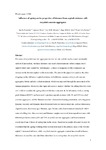Mostrar o rexistro simple do ítem
Influence of ageing on the properties of bitumen from asphalt mixtures with recycled concrete aggregates
| dc.contributor.author | Pasandín, A.R. | |
| dc.contributor.author | Pérez Pérez, Ignacio | |
| dc.contributor.author | Oliveira, Joel R.M. | |
| dc.contributor.author | Silva, Hugo M.R.D. | |
| dc.contributor.author | Pereira, Paulo A.A. | |
| dc.date.accessioned | 2018-03-07T18:59:21Z | |
| dc.date.available | 2018-03-07T18:59:21Z | |
| dc.date.issued | 2015 | |
| dc.identifier.citation | Pasandín, A.R., Pérez, I., Oliveira, J.R.M., Silva, H.M.R.D, Pereira, P.A.A. (2015). Influence of ageing on the properties of bitumen from asphalt mixtures with recycled concrete aggregates. Journal of Cleaner Production, v. 101, 165-173. | es_ES |
| dc.identifier.issn | 0959-6526 | |
| dc.identifier.uri | http://hdl.handle.net/2183/20290 | |
| dc.description.abstract | [Abstract:] The reuse of recycled concrete aggregates in new hot-mix asphalt can be a more sustainable method of production, but these mixtures may need a heat treatment before compaction to improve their water sensitivity performance. A direct consequence of this treatment is an increase in the hot-mix asphalt resilient modulus. The aim of this paper is to analyse the effect of ageing on the stiffness of asphalt mixtures with different amounts of recycled concrete aggregates, before and after a heat treatment, which was analysed through the assessment of its bitumen properties. Moreover, this paper also aims to analyse whether the rolling thin-film oven test is able to simulate the ageing effect of the heat treatment. In the laboratory work, a paving grade bitumen B50/70 has been used to produce asphalt mixtures with 0% and 30% recycled concrete aggregates, and the bitumen was later characterised (using penetration, softening point, dynamic viscosity and dynamic shear rheometer tests) in various situations, such as when using virgin bitumen, short-term aged bitumen, aged bitumen after heat treatment (simulated with 4 hours of rolling thin-film oven test) and bitumen samples recovered from asphalt mixtures with different production mixes (0% and 30% recycled concrete aggregate) and heat treatment conditions (0 and 4 hours of curing time in the oven). Based on the results obtained, it could be concluded that the ageing resulting from the heat treatment is the primary cause of the hot-mix asphalt’s increased stiffness, while recycled concrete aggregate content has a small influence. Moreover, it could be concluded that when there is no curing time, the recycled concrete aggregate protects the bitumen against ageing. Additionally, it could be stated that the rolling thin-film test is able to adequately simulate the ageing effect of the heat treatment. Thus, this test is useful for determining the ageing suffered by the bitumen when the recycled concrete aggregate mixture is manufactured using a heat treatment. | es_ES |
| dc.language.iso | eng | es_ES |
| dc.publisher | Elsevier | es_ES |
| dc.relation.uri | https://doi.org/10.1016/j.jclepro.2015.03.069 | es_ES |
| dc.subject | Hot-mix asphalt | es_ES |
| dc.subject | Recycled concrete aggregates | es_ES |
| dc.subject | Bitumen ageing | es_ES |
| dc.subject | Rheology | es_ES |
| dc.subject | Viscosity | es_ES |
| dc.subject | Bitumen properties | es_ES |
| dc.title | Influence of ageing on the properties of bitumen from asphalt mixtures with recycled concrete aggregates | es_ES |
| dc.type | info:eu-repo/semantics/article | es_ES |
| dc.rights.access | info:eu-repo/semantics/openAccess | es_ES |
| UDC.journalTitle | Journal of Cleaner Production | es_ES |
| UDC.volume | 101 | es_ES |
| UDC.startPage | 165 | es_ES |
| UDC.endPage | 173 | es_ES |
| dc.identifier.doi | 10.1016/j.jclepro.2015.03.069 |
Ficheiros no ítem
Este ítem aparece na(s) seguinte(s) colección(s)
-
CITEEC-CGM - Artigos [93]






